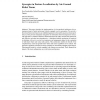Free Online Productivity Tools
i2Speak
i2Symbol
i2OCR
iTex2Img
iWeb2Print
iWeb2Shot
i2Type
iPdf2Split
iPdf2Merge
i2Bopomofo
i2Arabic
i2Style
i2Image
i2PDF
iLatex2Rtf
Sci2ools
ISER
2004
Springer
2004
Springer
Synergies in Feature Localization by Air-Ground Robot Teams
Abstract. This paper describes the implementation of a decentralized architecture for autonomous teams of aerial and ground vehicles engaged in active perception. We provide a theoretical framework based on an established approach to the underlying sensor fusion problem [3]. This provides transparent integration of information from heterogeneous sources. The approach is extended to include an information-theoretic utility measure that captures the task objective and robot inter-dependencies. A distributed solution mechanism is employed to determine information maximizing trajectories and assignments subject to the constraints of individual vehicle and sensor sub-systems. This architecture enables the benefit of the complementary aerial and ground based vehicle and sensor capabilities to be realized. The approach is applied to missions involving searching for and tracking multiple ground targets. Experimental results for vehicles equipped with cameras are presented. These illustrate th...
Ground Based Vehicle | Information-theoretic Utility Measure | ISER 2004 | Robotics | Sensor Fusion Problem |
| Added | 02 Jul 2010 |
| Updated | 02 Jul 2010 |
| Type | Conference |
| Year | 2004 |
| Where | ISER |
| Authors | Ben Grocholsky, Selcuk Bayraktar, Vijay Kumar, Camillo J. Taylor, George J. Pappas |
Comments (0)

